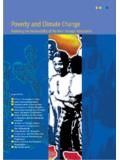Transcription of Pakistan - WHO
1 HEALTH SITUATION. Pakistan Pakistan is facing a double burden of disease (BoD), with endemicity of hepatitis B and C with affected individuals; the 5th highest tuberculosis burden in the world, and focal geographical area of malaria endemicity. The overall HIV prevalence of , although of those who inject drugs are using sterile injecting equipment. Estimated antiretroviral therapy coverage is In addition, the country has high rates of unscreened blood transfusions. Drug-resistant tuberculosis is estimated at among new cases and among previously treated cases. Vaccine preventable diseases and new emerging infections call for strengthening disease surveillance and response system. High government commitment and partners engagement resulted in a dramatic drop in the number of polio cases to only 08 cases reported from 7 districts in 2017, as compared to 20 cases from 14 districts in the preceding year. Non-Communicable Disease along with Injuries and Mental health now constitute the other half of BoD.
2 Injuries account for more than 11% of the total BoD, and are likely to rise with th increasing road traffic, urbanization and conflict. Pakistan is ranked 7 in the world for diabetes prevalence. One in four adults over 18 years of age is hypertensive, coupled with elevated smoking levels. Disability due to blindness or other causes is also high, and services for disabled population are limited, including provision of assist devices to improve their quality of life. Maternal deaths prevail due to preventable causes such as sepsis and haemorrhage, combined with high neonatal mortality rates. In young children, diarrhoea and respiratory illness remain as the major killers. The estimated prevalence of various forms of malnutrition conditions in children under 5 years is: underweight, wasting, severe wasting, http:// stunting and overweight. Half of women of reproductive age are anemic ( ). Increasing political commitment to maternal, newborn, and child health is reflected in the WHO region Eastern endorsed national vision and the Ten Point Priority Agenda for RMNCAH & Nutrition 2016.
3 Mediterranean 2025. The BoD is rendered worse by an increasing population, with Pakistan now the sixth most World Bank income group Lower-middle-income populous country in the world having a growth rate of per annum, contraceptive prevalence of 35% and unmet need for birth spacing of 25%. Child health The health system functions and operations are frequently disrupted by acute crises such as Infants exclusively breastfed for the first six months of life (%). (2013). 38 floods, droughts, earthquakes, manmade emergencies as well as disease outbrea ks such as Dengue and Measles. Chronic factors affecting the health systems include low GDP allocation Diphtheria tetanus toxoid and pertussis (DTP3) immunization coverage among 1-year-olds (%) (2015) 72 to social sector and an overall slow economic growth, on-going conflict in several areas of the Demographic and socioeconomic statistics country, and over-arching governance challenges affecting the public sector. Moreover, ODA. (Both sexes).
4 Remains around 2% of total health expenditure in Pakistan , which is relatively insufficient. Life expectancy at birth (years) (2015) (Female). (Male) HEALTH POLICIES AND SYSTEMS. The health system has been devolved to eight federal units (provinces and administrative areas). Population (in thousands) total (2015) 207,774. through the 18th constitutional amendment of 2010, whereby strategic planning also became a % Population under 15 (2015) 35 provincial responsibility. Health system in Pakistan is a mixed system of a large government % Population over 60 (2015) infrastructure of primary and secondary health facilities in rural and peri-urban areas, and large Poverty headcount ratio at $ a day (PPP) (% of teaching hospitals in urban areas. An extensive private medical sector is widely used and 21. population) (2008) consulted. NGOs and the philanthropic sector have their part by delivering mostly preventive Literacy rate among adults aged >= 15 years (%) (2007-2012) 55 services.
5 Complementary, alternative and traditional system of healing is also quite popular in Pakistan . Prime Minister Health Insurance Porgramme is a big achievement that will cover Gender Inequality Index rank (2014) 121. secondary and tertiary care of above Million poor at the initial phase from 24 districts. Human Development Index rank (2014) 147 Primary health care services are provided through a well-established infrastructure of over 7500. Health systems first level care facilities and outreach services in the public sector. More than 100 000 lady Total expenditure on health as a percentage of gross health workers provide primary health care services at the doorstep for rural and slum urban domestic product (2014) areas. Access to and affordability of essential medicines are integral to universal health Private expenditure on health as a percentage of total coverage, particularly as a large part of out of pocket and public expenditures is on medicines. expenditure on health (2014).
6 The health system faces challenges of verticalized service delivery and low performance General government expenditure on health as a percentage of accountability within the government, creating efficiency and quality issues. The public sector is total government expenditure (2014). inadequately staffed and job satisfaction and work environment need improvement. The overall Physicians density (per 1000 population) (2015) 10 health sector also faces an imbalance in the number, skill mix and deployment of health Nursing personnel density (per 10 000 population) (2015) workforce, and inadequate resource allocation across different levels of health care. The National Health Vision 2016-2025 strives to provide a responsive national direction to confront Mortality and global health estimates various health challenges, keeping Universal Health Coverage as its ultimate goal. The principle Neonatal mortality rate (per 1000 live births) (2015) [ ] values include: good governance, innovation and transformation, equity and pro-poor approach, responsiveness, transparency and accountability and integration and cross sectoral synergies.
7 Under-five mortality rate (probability of dying by age 5 per [ ]. 1000 live births) (2015). COOPERATION FOR HEALTH. Maternal mortality ratio (per 100 000 live births) (2015) 178 [ 111 - 283] Foreign assistance has played a critical role in developing Pakistan 's health sector and the Births attended by skilled health personnel (%) (2012-2013) country has historically received large volumes of aid. ADB, Governments of US, UK, Germany, Norwegian and Australia, CIDA, DFID, GIZ, JICA, KOICA, UNICEF, UNFPA and WB are among the Public health and environment major donors with different areas of interest and mandate. In addition Pakistan has a relatively (Urban). Population using improved drinking water sources (%) (2015) (Rural) sizeable non-profit private sector with more than 80 000 not for-profit nongovernmental (Total) organizations. The overall investment in the health services sector during 2009 was US$ (Rural) billion, with the government providing 24%, donors 6%, the military 4%, and 1% through social Population using improved sanitation facilities (%) (2015) (Total) security.
8 The remaining 65% was paid by individuals as out-of-pocket medical expenses. The (Urban). UNCT coordinates all external support from bilateral and multilateral donors that support the Sources of data: One UN joint programmes including that on health and population. OCHA is the key agency for Global Health Observatory May 2017. coordination of humanitarian support. In 2017, WHO has taken the chairmanship of the Health, Population and Nutrition Partners Group, a quarterly coordination platform that aims to streamline donor support in Pakistan . WHO COUNTRY COOPERATION STRATEGIC AGENDA (2011 2017). Strategic Priorities Main Focus Areas for WHO Cooperation STRATEGIC PRIORITY 1: WHO will support improvements in policy-making and governance through policy assessment and analysis and review the Health policy and system development health system with a view to outline gaps and propose solutions as part of the national health policy/strategy. Pakistan will also assist to improve service delivery, access and equity through development of an integrated framework for the provision of comprehensive quality and equitable health care to the population.
9 In addition WHO will support Prime Minister Health Insurance Programme and advocate for more adequate budget allocations for health (aiming at a minimum of 4% of GDP by 2017). Pakistan should be given opportunity to increase external resources (ODA) to support critical aspects of health sector reform at provincial level and promote coordinated approaches and effective use in view of the devolution process. Developing public private partnership and managing human resources for health, developing an integrated health information system and promoting and supporting applied research are other components to enhance Health policy and system development in Pakistan . STRATEGIC PRIORITY 2: Disease surveillance and early warning systems will be supported for the detection and timely control of communicable Communicable disease control diseases including polio, tuberculosis, malaria, HIV/AIDS, leishmaniasis, hepatitis, acute watery diarrhoea, acute respiratory infection, malaria, dengue fever, Crimean Congo haemorrhagic fever among others.
10 Support will also be provided for improving routine immunization through collaboration with partners specifically GAVI. STRATEGIC PRIORITY 3: WHO will support the provincial health departments in improving mother, newborn and child health/reproductive health Improving the health of women and in collaboration with other stakeholders and UN sister agencies. Promoting safe motherhood, family planning, prevention children and control of sexually transmitted infections and reduction of neonatal and peri-natal mortality and implementation of provincial plan on reducing Maternal and neonatal heath are among major interventions that will be supported by WHO. STRATEGIC PRIORITY 4: Support development of national noncommunicable strategy addressing minimizing negative impacts of risk factors and Noncommunicable diseases and mental advocating multisectoral public policies and strengthening partnership, public private partnership and accelerate health implementation of the provisions of the WHO Framework Convention on Tobacco Control.
















